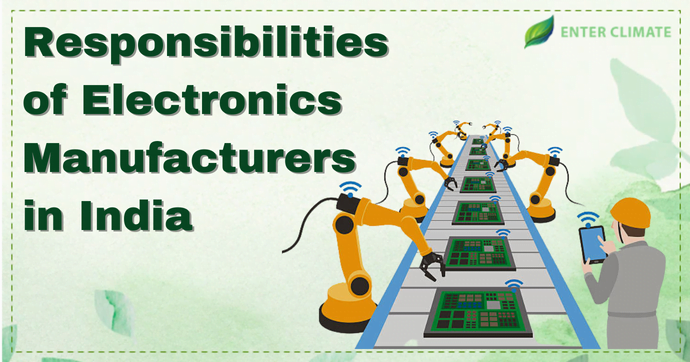A Guide to EV Charging in India: Regulations and Incentives
 25 Oct, 2023
25 Oct, 2023 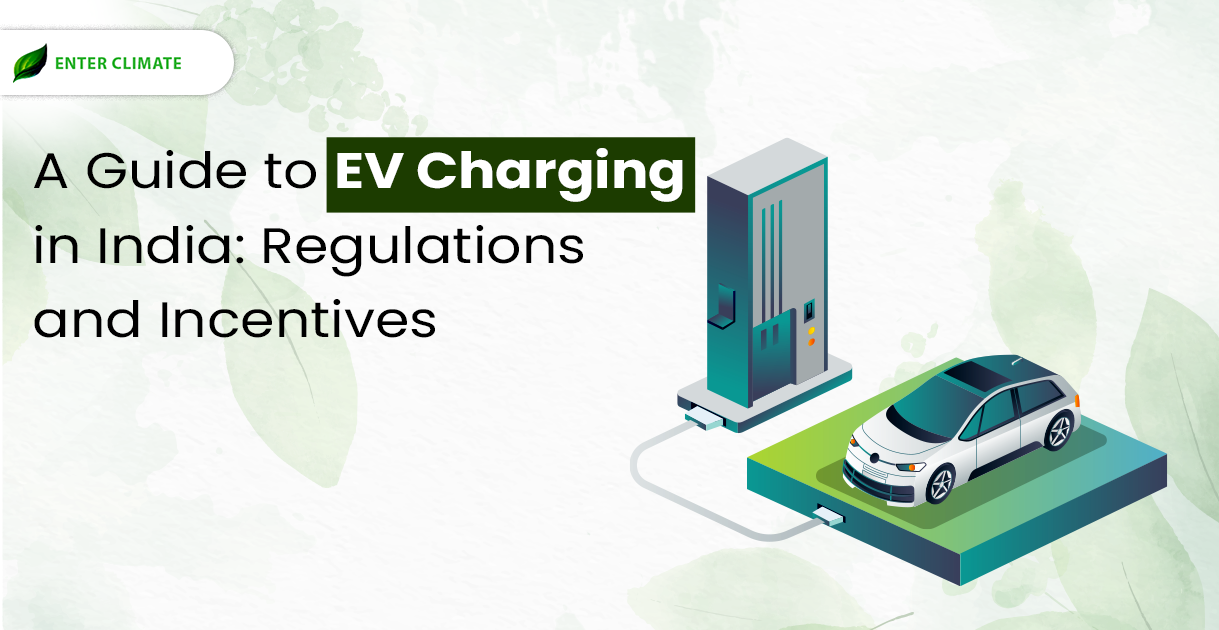
Are you contemplating setting up a public EV Charging Station in your area and are wondering what are the regulations imposed and incentives provided by the government regarding the same? We can witness the rapid pace at which the electrification of the transport sector is happening around us. India has been the world’s 3rd largest automobile market in terms of volume of sales, and in the year 2022, the worth of the Indian automobile sector crossed USD 100 billion, thereby giving a huge impetus to the country’s economy.
However, Electronic Vehicles (EVs) only held comparatively a modest share of this narrative, but there has been an increased growth in their adoption, and even the future of the EVs in India seems bright. Although it is at a nascent stage in India’s sustainable development strategy, EVs can play a pivotal role in its transition towards green energy and can help India achieve its zero emissions target by 2070.
In this article, we will highlight the policies relating to EVs along with the incentives introduced by the government of India to promote the market for EVs and will further take up the regulatory details relating to establishing an EV charging business in India.
The Need for EVs in India
With the growing environmental concerns, there has been a constant effort to shift to environmentally friendly options across sectors, and the same holds true for the transport industry of the country, which is one of the chief contributors to CO2 and greenhouse gas emissions leading to environmental pollution, climate change and causing health hazards. Therefore, a shift towards EVs is not just a matter of convenience but an imminent need as well to pave the way for a greener and cleaner future.
Apart from being an environmentally sustainable option, they are also quite economical as compared to traditional internal combustion engine automobiles. EVs are more energy-efficient and have a lower operational cost attached to them. Although they do require an initial investment, they tend to offer long-term economic benefits.
In addition to that, the use of EVs in India reduces our dependence on oil imports, which makes us susceptible to global price variations, as they run entirely on electricity. This electricity can be produced from various renewable sources such as hydroelectricity, solar energy, wind, etc. This helps India reduce its dependence on imported fossil fuels, particularly oil, which often leads to trade deficits.
Growth Perspective of the EV Industry
As per the reports, the EV Industry in India has been showing prominent growth, with around 1.2 million EV units sold, and this has led to a rise of positive expectations in terms of an inflow of investment of around USD 200 billion in this industry by 2030.
In fact, the market size is expected to reach USD 37.68 billion by 2028; that is to say, it will witness a growth of 46.38% between 2023-2028. This has only been possible due to the fervent support the EV industry has been receiving from both the Central Government and the State Governments. Many states have come up with their own EV Policies with the objective to incentivise the buyers as well as the Original Equipment Manufacturers. The predominant intention is to hasten the adoption of EVs and thereby create a hub for FDI.
If the industry can maintain this momentum of growth, it has been anticipated that every year around 106 million EVs will be sold by 2023 and to keep up with this pace, and according to a report furnished by the Confederation of Indian Industry (CII) titled Charging Infrastructure for Electric Vehicles, to promote this rapid implementation and adoption of EVs, India will need a minimum of 1.32 million charging stations by 2030, to meet this demand.
EV Charging Infrastructure in India
Now, in order to encourage the adoption of EVs in India, there is a key requirement of establishing a robust EV Charging infrastructure in the country, and so far, the government has installed approximately 1700 operational public EV charging stations. In addition to these, the government has also taken various initiatives to develop the EV charging infrastructure by involving public and private agencies to further this process.
The key players in EV charging infrastructure in India are:
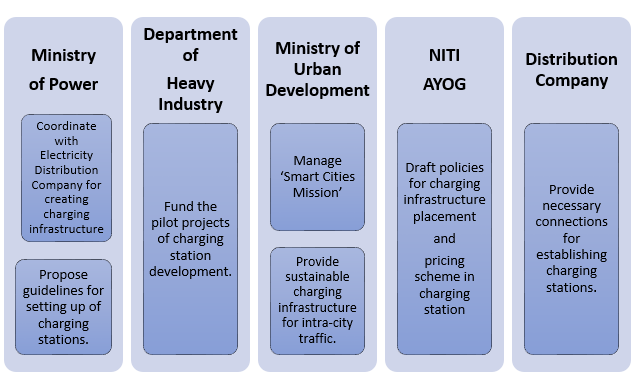
Guidelines for EV Charging Infrastructure in India
Since the availability of EV charging stations is the major key component of the entire electrification process, the Ministry of Power released a comprehensive plan for setting up of EV charging stations in 2018, and certain guidelines were highlighted and proposed, with the following objectives in mind:
- To promote the adoption of EVs in India by ensuring safe, accessible, dependable and affordable EV Charging Infrastructure in the nation
- To promote affordable tariff chargeable from EV owners and EV charging station owners
- To contribute to generating employment and income opportunities in this sector, especially for small businesspersons
- To make positive efforts for the development of EV charging infrastructure in India and thereafter create a market for EV charging business.
Setting up of EV Charging Stations
With these objectives and aims in mind, the following major guidelines have been issued for businesses or entities who are interested in setting up EV charging stations:
- Private EV charging stations have been allowed at residential/official spaces, and the same will be facilitated by DISCOMs
- Public EV Charging Stations have been delicensed, which means any person is now free to set up a public EV charging station, provided he meets the other prescribed technical protocols and norms.
- The person or business interested in setting up a public EV charging station will be required to apply for connectivity, and the Distribution Company Licensee shall provide these connections on priority.
- Interested businesses and persons are also free to obtain electricity from open access as well.
Minimum Infrastructural Requirements to Set up Public EV Charging Stations
Each and every ‘public’ EV charging station is required to meet the following minimum requirements in order to be able to function:
- Each EV charging station must possess an exclusive transformer along with all necessary equipment.
- 33/11 KV line with the necessary equipment
- Appropriate civil works
- Adequate space for charging, entry and exit of EVs
- Must have an Electric Kiosk with all charger models installed as follows:
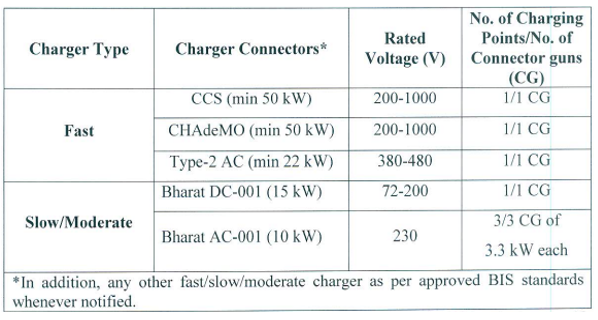
Source: Charging Infrastructure For Electric Vehicles-Guidelines and Standards, issued by Ministry of Power, dated 14.12.2018
- Interested entities are allowed to create EV Charging Hubs and are free to install an additional number of kiosks or chargers in addition to the minimum charges prescribed in the above table.
- These entities will also be required to join hands and tie up with at least one online NSP, i.e. Network Service Providers, so that EV owners can book charging slots online.
- An additional responsibility has been placed on the EV charging station owners to maintain the protocols as prescribed and share the station data with the concerned DISCOM.
- In case the entity is also interested in providing a fast charging facility at its EV charging station, it must make the necessary arrangements for the following:
- Appropriate Liquid Cooled Cables
- Appropriate climate Control Equipment
Note: These above-mentioned minimum requirements have been prescribed only for ‘public’ EV charging stations, which means private/residential charging stations need not comply with these.
Guidelines Relating to the Location of Public EV Charging Stations
In addition to the above-prescribed guidelines and minimum requirements, the ministry has also laid down certain guidelines with regard to the density of these EV charging stations, i.e. the distance between two charging stations:
- There must be at least one EV charging station in the grid of 3km x 3km.
- There must be one EV charging station at every 25 km on both sides of the road or highway.
- For long-range EVs or heavy-duty EVs like SUVs, buses, etc., there must be at least one fast charging station at every 100kms, one on each side of the road or highway and within cities; these heavy charging stations are to be established within bus depots, transport nagars, etc.
Tariff Guidelines for Supply of Electricity to Public EV Charging Stations
The tariff for electricity supply to public EV charging stations will be determined by the commission concerned; however, the same cannot be above average charge of supply with an addition of 15%.
Government Initiatives to Enhance the EV Charging Infrastructure
To promote a smooth transition towards the adoption of EVs in India, the government of India has initiated a slew of incentives and policies, making it profitable to pivot to EVs in India, particularly in the area of EV Charging. Some of these policy initiatives are:
NEMMP
In 2013, the government launched the National Electric Mobility Mission Plan (NEMMP) to promote faster adoption of EVs in India. The plan was launched with the aim of reducing the 9500 million litres of oil in its quest for national fuel security.
The plan was launched in two phases; one is the pilot phase from 2012-2105 by launching FAME India, and the other is the NEMMP 2020 Programme between 2013-2020. Under this plan, the charging stations would be first set up at megacities, followed by the state capitals and headquarters of the Union Territories.
FAME India
The government of India launched the Faster Adoption and Manufacturing of (Hybrid &) Electric Vehicles in India (FAME India) Scheme in 2015 for a two-year period that lays down the roadmap to bring down India’s overall dependency on fossil fuels with an intent to reduce the carbon emissions. In the same year, in March, the Ministry of State of Power, Coal, New and Renewable Energy announced to attain 100% E-mobility by 2030.
Currently, from 2019 onwards, the second phase of the FAME Scheme is in force with an outlay of INR 10,000 crores, including the 366 crores spillover from FAME-I out of which 86% of the fund has been assigned to create demand for EVs in India. The following incentives have been offered under the scheme:

NEMMP 2020 Programme
The NEMMP programme came into force in 2020 with an aim to introduce 6 to 7 million EVs on the road with an outlay of Rs 75 crores and with a vision for EV market development by providing demand incentives, domestic technology development and enhancing domestic production, in order to attain self-reliance. To further incentivise the buyers and to encourage them to buy EVs, the government plans to make the EVs available at a lesser price by reimbursing the price difference directly to the manufacturer.
Phased Manufacturing Programme (PMP)
The government of India has also developed a phased roadmap to boost electric mobility, keeping in mind the current status of the manufacturing sector of the country by enhancing the production capacity of the same. This roadmap has incorporated a graded duty structure for manufacturing EVs in India, assembling and sub-assembling their parts or inputs.
PLI Scheme
The Production Linked Incentive (PLI) Scheme for the Automotive Sector was launched in September 2021 with the objective to boost the domestic manufacturing of EVs and attract further investments in the automotive industry. The scheme has been successful in attracting an investment of INR 74,850 crores against the target estimate of INR 42,500 crores over a period of five years.
Other Measures to Promote Adoption of EVs in India
Apart from these targeted schemes and initiatives, the government of India has taken several proactive measures to enhance green mobility by promoting the use of EVs in India, such as:
- Exemption from Import Duty: In 2023-2024, in its Union Budget, the government of India exempted the import duty on the capital goods and machinery which is required for the manufacturing of lithium-ion cells for batteries that are used in EVs in India.
- Reduced GST: Another measure to give impetus to the adoption of EVs in India, the government has reduced the GST slab on EVs in India from 12% to 5% and from 18% to 5% on the charging stations for EVs in India.
- License Exemption: Furthermore, the government has exempted both commercial and private battery-operated vehicles from the permit requirements and has instead given green license plates.
- Waiver of Road Tax: To reduce the operational cost burden, the government has waived the road tax on EVs in India.
- Providing Subsidies: The government is aiming to prioritise developing the charging infrastructure for EVs in India by vehemently promoting the installation of EV charging stations by providing various subsidies and introducing guidelines to strengthen the ccc.
- Collaborating with private and public companies: At the same time, the government is luring in the private and public sector giants to install EV charging stations; for instance, the Oil marketing companies have decided to set up around 22,000 EV charging stations across several major cities and on national highways in the nations.
- The Department of Heavy Industries has also endorsed 2636 EV charging stations in 62 cities across 24 States and UTs under phase -II of the FAME India scheme. State-wise allocation of these charging stations is as follows:
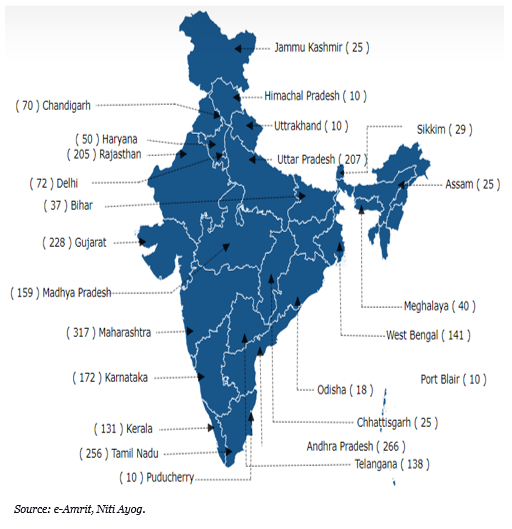
Conclusion
India’s transition to EVs is a profound shift that will not only address the environmental and energy concerns of the nation but will also be economically beneficial in the long run. This seismic change will hopefully be able to reduce our trade deficits by reducing our dependence on oil imports and creating a plethora of opportunities for employment in the nation.
The government has been proactively taking strategic initiatives such as the implementation of the FAME Scheme, providing subsidies and investing rigorously in developing the EV charging infrastructure in the country to demonstrate its commitment to promoting electronic mobility. Therefore, entrepreneurs looking to enter the EV charging business in India have a unique opportunity to enter this booming industry and profit from this rising market for EVs in India.
FAQs:
Currently, India has 1 charging station for every 135 EVs, which is very low compared to the global average of 6:20. This gap in India can be attributed to various factors such as increased cost of investment, inadequate power grid, etc.
Public Policy plays a significant role in the development of charging infrastructure in India. It is only due to the favourable policy initiatives taken by the government that this technological transition and electrification of the transport industry has been possible. With schemes like FAME India and NEMPP, recent developments have been made possible in the charging infrastructure of India.
The Central Electricity Authority (CEA) Regulations are responsible for regulating the EV charging infrastructure in India, especially relating to technical and safety requirements.
Yes, the government provides various incentives for setting up EV charging stations in India in the form of subsidies, waivers of certain taxes, license exemptions, reduced import duties, reduced GST tax, etc.
The development of EV charging infrastructure in India can give impetus to the adoption of EVs by the people of India, which will significantly reduce the air pollution caused by the burning of fossil fuels, which in turn will not only reduce environmental pollution but also contribute in mitigating the climate change issues. It also helps in reducing our dependence on and depletion of non-renewable sources of energy, thereby leading to a sustainable use of natural resources.
The EV owners and consumers also benefit from the adoption of EVs as they are not only environmentally-friendly, but also their running cost is much lower than the traditional automobiles, which run on fossil fuels like petrol or diesel. In addition to this, EVs also have a low maintenance cost because of fewer servicing requirements. The government also provides various tax and financial benefits in terms of waiver of road tax or other state-specific benefits to EV users.
Yes, EV buyers are entitled to claim an exemption of INR 1.5 Lakhs income tax deduction under Section 80 EEB of the Income Tax Act on the interest paid for vehicle loans.
It has been anticipated that every year around 106 million EVs will be sold by 2023, and to keep up with this pace, according to a report furnished by the Confederation of Indian Industry (CII) titled Charging Infrastructure for Electric Vehicles, to promote this rapid implementation and adoption of EVs, India will need a minimum of 1.32 million charging stations by 2030, to meet this demand.
Yes, the Government of India has collaborated and joined hands with the private and public giants to install EV charging stations; for instance, the Oil marketing companies have decided to set up around 22,000 EV charging stations across several major cities and on national highways in the nations. The Department of Heavy Industries has also endorsed 2636 EV charging stations in 62 cities across 24 States and UTs under phase -II of the FAME India scheme.
There are many challenges faced in implementing the EV charging infrastructure in India, such as specialised technical safety concerns, inconsistent voltage, lack of accessibility to public EV charging stations, difficulty in integrating the EV infrastructure with the current power grid, etc.
Categories
Latest Post
Air pollution Dispersion Modeling
Natural Disaster Risk Assessment
Endangered Species Protection
Aquifer Recharge Project
Sustainable Sanitation Solutions














